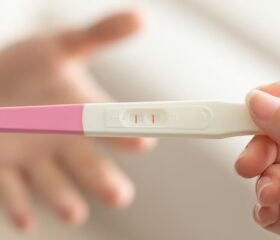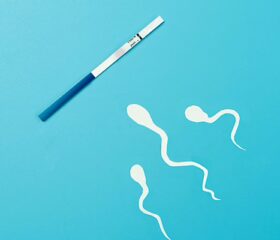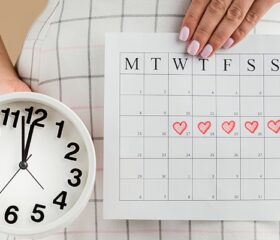Ovulation Test Strips: What Are They and How They Work
Whether you’re trying to get pregnant or avoiding it at all costs, ovulation test strips are handy tools that can help you reach your goal.
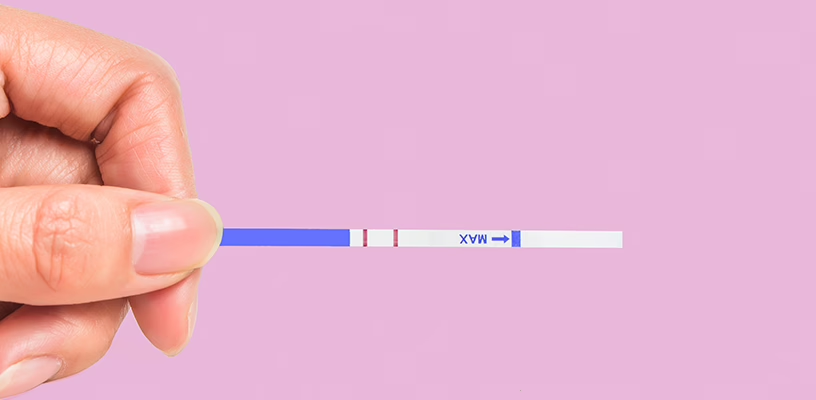
These strips help you identify which days of the month you’re most fertile, which can help you conceive—or figure out when you should abstain from sex or be extra-vigilant about birth control.
Read on to learn more about what ovulation test strips are, how to use them, when they might not be useful, and what other ovulation-tracking options there are.
What are ovulation test strips?
Ovulation test strips, or ovulation predictor kits (OPK), are at-home tests you can use to find out when you’re most fertile. You can buy them at your local pharmacy or drugstore.
How do ovulation test strips work?
Ovulation test strips check the levels of luteinizing hormone (LH) in your urine. If the strip detects a surge of this hormone, it means your ovary is about to release a mature egg soon, and you’re more likely to get pregnant if you have unprotected sex now. 1
To take the test, pee directly on the test or dip it into a cup you peed in. The results will show up within a few minutes. What the results will look like will depend on the type of test you use, but typically, it’ll turn a darker color or otherwise show a clear visual sign if it detects a surge in your LH.
Types of ovulation test kits
There are two types of ovulation test kits—ones with paper strips and ones with sticks. Here’s how they work:
- Paper strips: These budget-friendly kits typically come with around 20–50 strips and a cup to pee in. The paper strips have two lines: a test line and a control line. With positive ovulation test results, the test line will appear darker than the control line; on a negative result, it’ll be lighter or not visible at all.
- Sticks: These kits usually cost more than paper strip kits. The sticks may be analog or digital; you can pee on them or dip them into a cup holding your urine. Like paper strips, analog sticks show a darker test line for a positive result. You may see a smiley face or a “yes” symbol on digital tests when you get a positive result.
If you use paper strips, you might see a faint line on them even when you’re not ovulating, as LH is present throughout your cycle. This can be confusing; the best way to figure out what your result means is to take several tests in a month to learn what a darker test line looks like for you.
Exactly how these tests work and how to read the results may vary slightly from kit to kit. Read the instruction booklet in your kit to use your test correctly.
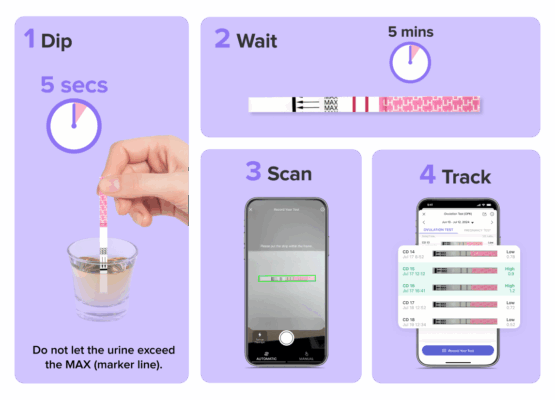
What’s the best time to use ovulation test strips?
The best time to use an ovulation test strip is around 3–5 days before you ovulate. 1 To do this, you need to keep track of your expected ovulation date either in your calendar or an ovulation tracker app (you’ll then use the strip to confirm the timeline further).
Ovulation typically happens midway through your menstrual cycle. If you have a 28-day cycle, you should start testing around day 11 (i.e., the 11th day after your last period started). If you have irregular cycles, ask your doctor for advice on how to tell when to take the test. 1
You can take the test at any time of the day, but it should be around the same time each day. To get the best results, make sure you haven’t peed for at least 4 hours beforehand. Additionally, don’t drink large amounts of fluids for a few hours before testing. Your urine might become too diluted, which can skew your test results by reducing the concentration of LH below what it would normally be. 21
How to maximize your chances of conception
Your chances of pregnancy are higher after seeing a positive ovulation test, so if you’re trying to get pregnant, it’s time to take action.
Don’t wait too long to have sex. Ideally, you’ll do it on both the day you got the positive result and the day after for the best chances of fertilization. In fact, since sperm can survive for up to 5 days in a woman’s body, for the absolute best chance, you’ll have had sex before ovulation as well.
Ovulation usually happens within 24–36 hours of your LH surge, and you’re most likely to get pregnant within 4–6 hours of ovulation. Although sperm can survive for up to 5 days, the egg only lives for about 24 hours after ovulation (at most). 13
Are ovulation kits accurate?
Ovulation test kits are fairly accurate when you use them correctly. Some studies suggest these tests can accurately predict ovulation up to 99% of the time. 4 That said, they do have limitations and are by no means foolproof.
A positive result merely indicates a surge in LH, which usually leads to ovulation, but bodies can behave in unpredictable ways, and that hormonal surge doesn’t guarantee that an egg will actually be released.
In addition, some people may have trouble testing due to other factors affecting their fertility:
- Irregular cycles: It can be harder to track ovulation with irregular periods, and you might find it tricky to know when to take an ovulation test. You can get pregnant with irregular periods, but you may need to test more often or find other ways to monitor your fertility.
- Underlying health conditions: Conditions like polycystic ovary syndrome (PCOS), which can cause unusually high levels of LH, may skew your test results. 56 If you’re trying to track ovulation with PCOS, you’re best off getting extra help from you doctor.
- Medications: Certain medications (e.g., fertility drugs) can also affect the accuracy of the tests.
All in all, ovulation tests are helpful tools to identify your most fertile window. However, if you’re having a hard time using them or getting pregnant, you should talk to your doctor. They’ll give you more thorough testing, help you better understand your cycle, and suggest alternative ways to track your fertility.
If you’re already pregnant, that may also lead to a false positive
When you’re pregnant, your placenta produces a hormone called human chorionic gonadotropin (hCG), which has a similar structure to LH. So if you’re pregnant, your ovulation test may be positive (or have a faint positive line). Of course, if you’ve already conceived, there isn’t much point in tracking your cycle—that ship has sailed!
How to choose the right ovulation test kit
With tons of brands on the market, it can be hard to pick one to buy. When you choose a test kit, look at its:
- Cost: Prices vary widely depending on the brand and the type of test. You’ll find that basic test strips are generally cheaper than digital tests.
- Reputation: Do your due diligence and look for brands with positive reviews (ideally ones recommended by reputable doctors or medical institutions).
- Number of tests: Check how many strips or tests are included in the kit, especially if you have irregular cycles and may need to test more often.
- Additional features: Some tests also measure your estrogen or progesterone levels, which can give you additional insight into your cycle.
By and large, experts agree that simple, inexpensive test strips can get the job done. You don’t necessarily need to spend lots of money to buy the fanciest tests.
Other ways to track your ovulation
Check out these other methods for tracking your ovulation and getting a more complete picture of your fertility cycle:
- Basal body temperature (BBT) method: Your BBT is your body’s temperature when resting. After ovulating, your basal body temperature may rise a little, so you might be able to figure out your ovulation pattern by tracking your temperature every morning before you get out of bed. However, this method isn’t perfectly reliable, and you’ll need to keep at it for at least three menstrual cycles. 7
- Cervical mucus monitoring: Your cervical mucus (a fluid produced by your cervix) will turn from thick, white, and dry to clear, wet, and slippery during your fertile window. 8 Conversely, if your mucus is thick, sticky, and cloudy, it could be a sign that ovulation is over. You can monitor it by checking your underwear or toilet paper or placing a clean finger on your vagina.
- Ovulation calculators: Many online tools and fertility tracker apps can help you predict your ovulation window—at least to an extent—by using information about your cycle length.
- Progesterone testing: Progesterone is a hormone that rises for around 5 days after ovulation. You can get a blood test that measures your progesterone levels at your doctor’s office to confirm if you’ve ovulated. 9 Doing so probably won’t help you conceive this month, but it can help you get a handle on your cycle for next month.
Final thoughts
Ovulation test strips aren’t foolproof, but they’re generally reliable and have helped a lot of women pinpoint their most fertile days and get pregnant.
If you’re one of the many hopeful moms trying to conceive, go ahead and pick up a test kit at your local drugstore—pregnancy is just around the corner!
Article Sources
- MedlinePlus. "Ovulation home test" Retrieved April 15, 2025.
- Time to Conceive. "Ovulation Predictor Test Instructions" Retrieved April 15, 2025.
- MedlinePlus. "Pregnancy - identifying fertile days" Retrieved April 15, 2025.
- Human Reproduction Open. "Real-life insights on menstrual cycles and ovulation using big data" Retrieved April 15, 2025.
- World Health Organization. "Polycystic ovary syndrome" Retrieved April 15, 2025.
- University of Virginia. "Patient Information" Retrieved April 15, 2025.
- Cleveland Clinic. "Basal Body Temperature" Retrieved April 15, 2025.
- Cleveland Clinic. "Cervical Mucus" Retrieved April 15, 2025.
- University of Rochester Medical Center. "Progesterone" Retrieved April 15, 2025.




